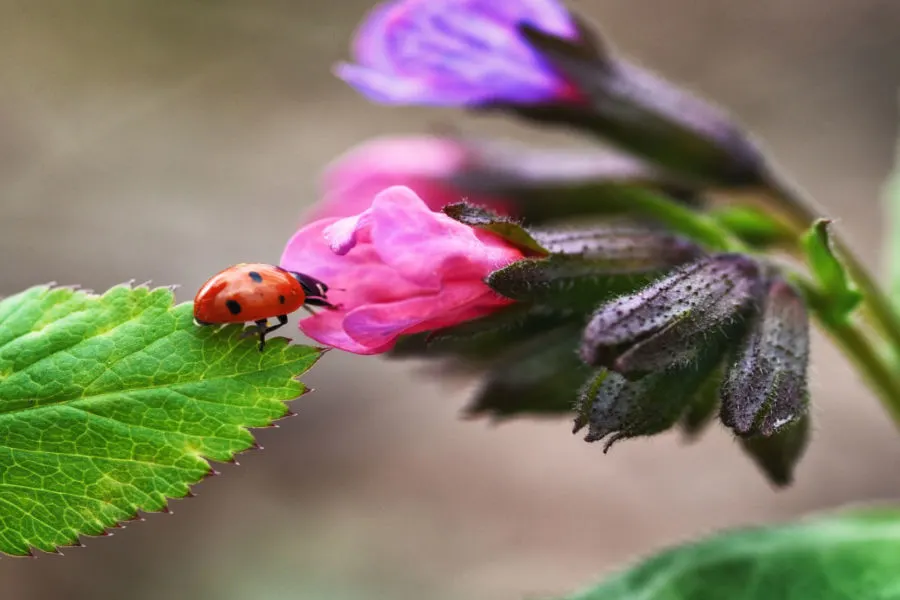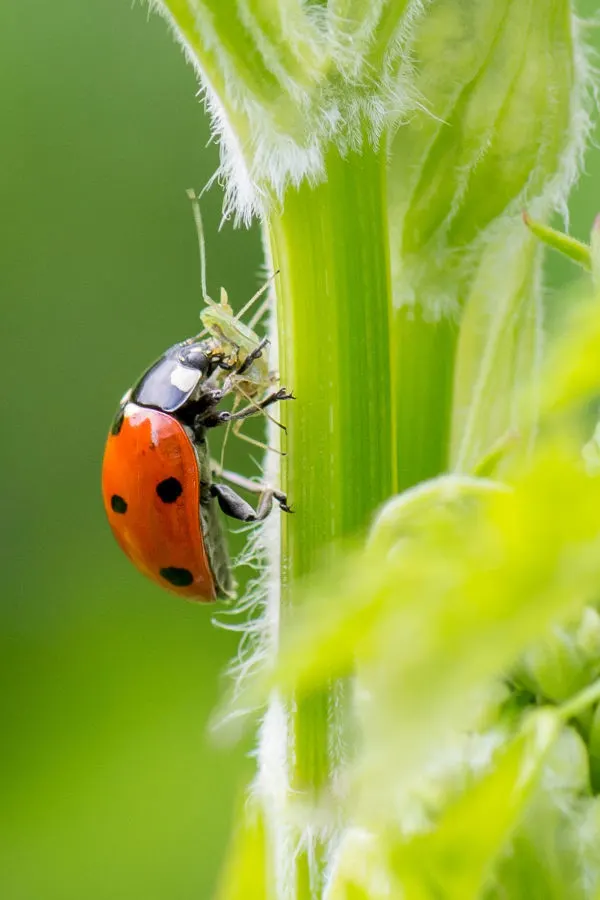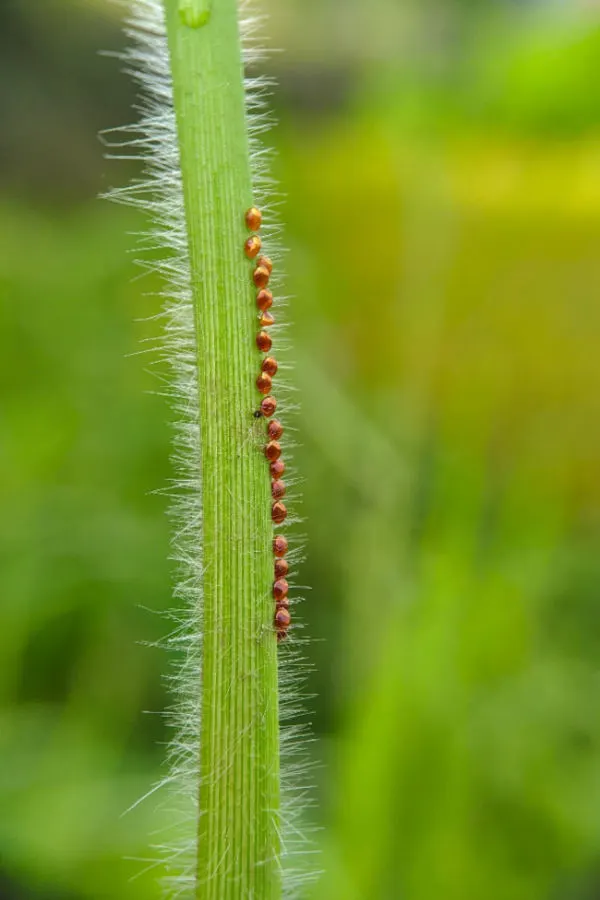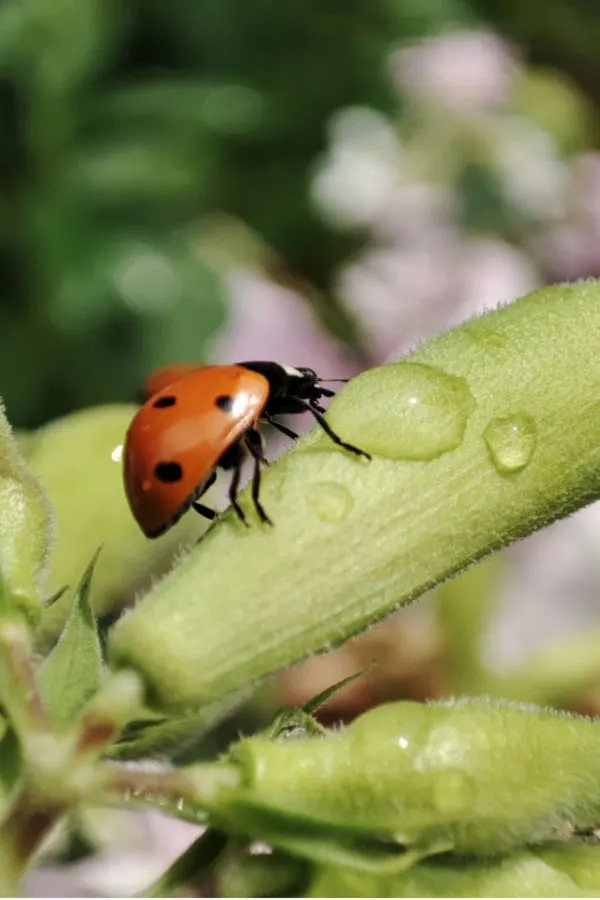Did you know that if you can simply attract ladybugs to the plants in your flowerbeds and vegetable garden – most of your pest and insect issues can disappear in a flash. And even better – you can actually have more blooms and vegetables too!
Ladybugs are one of the most beneficial insects of all for gardeners. Not only do they brighten up plants with their colorful spotted shells, they also happen to eliminate entire colonies of plant pests in quick fashion.
But if you thought ladybugs were only great for their pest killing skills, think again! They also happen to be quite amazing when it comes to pollinating plants as well.

As ladybugs stroll along the blooms and leaves of plants searching for their next insect meal, their body, feet and wings move pollen from plant to plant. As they do this, they carry that pollen from flower to flower, helping to fertilize blooms in astounding numbers.
With all of those benefits in mind, today’s article takes an in-depth look at all of the amazing pests ladybugs can help you control in your landscape – as well as some of the best methods and tips for attracting them into your yard to work their magic!
The Insects Ladybugs Love – How To Attract Ladybugs To Your Plants
First and foremost, ladybugs are insect eating machines. In fact, as you will see with the list below, there are not many small pests that ladybugs won’t eat. Here are some of the most common garden and plant pests that ladybugs love to dine on:
Aphids – Aphids can overtake plants in short order. When unchecked, they can double their population in mere days. But the good news? Ladybugs can’t resist eating them. Aphids are among the favorite prey of ladybugs. A single ladybug will devour more than 5,000 aphids in its lifetime!

Whiteflies – Whiteflies feed on plant juices and can weaken and kill plants quickly. For plants like tomatoes and peppers, they can severely limit fruit production as well. But Ladybugs once again can easily keep whitefly populations under control, eating both adults and larva.
Mealybugs – Mealybugs suck the sap directly out of plants, leaving the foliage lifeless. But ladybugs often lay their own eggs right in the mealybugs colony. And when their eggs hatch, the ladybug larvae feast on mealybugs, destroying their entire colony and habitat in the process.
Potato beetles – Potato beetles in enough numbers can prove to be fatal for any plant. Ladybugs consume potato beetles and even European corn borer, thereby reducing plant damage.
Spider Mites – A single ladybug can consume up to 100 spider mites daily. Even if your garden is infested with spider mites, attracting even a few ladybugs will drastically reduce the population and the damage they cause. But it doesn’t end just there. Ladybugs also will consumer thrips, maggots, lace bugs and more.
How To Attract Ladybugs To Your Plants
So it’s easy to see just how beneficial ladybugs can be in your flowerbeds and gardens – but how can you get them there in the first place? And even more importantly, how can you get them to stay once they arrive?

Plant The Plants Ladybugs Love
The first key to success is to plant the plants that ladybugs love most. Ladybugs will work a wide variety of plants, but they are most attracted to plants that have flat flowers as their blooms. The reason is that these act like landing pads for ladybugs.
Ladybugs also love to visit plants that bloom in white or lighter-colored flowers. Sweet Alyssum, Dill, Chives, Fennel and Yarrow are favorites. But standard big blooming annuals such as marigolds, cosmos and zinnias will also attract ladybugs too.
Plant Plants That Pests Love Too – How To Attract Ladybugs To Your Plants
Apart from growing plants that attracts ladybugs, you also need to plant ones that the pests ladybugs love to eat will visit. These are often called trap or decoy plants, and they are vital in attracting the insects that ladybugs need for their diet.
Luckily, many of these are traditional garden vegetable plants, such as cucumbers, tomatoes and potatoes. It may sounds crazy, but there needs to be a balance of good pests and bad pests. A few whiteflies, aphids and beetles cannot destroy a crop, but having some around provides food for the ladybugs – which will keep them as permanent residents!
This is why widespread spraying can be so detrimental to pest management. If you kill off all of the insects, even the good ones that remain will leave. And when other bad pests move back in, there is nothing to help fight them off. See : How To Keep Aphids Out Of Your Garden – Without Using Chemicals!

Once you attract ladybugs, the population of harmful insects will automatically reduce. And from there on out, all of the insects can live at levels that will not harm crops, but keep the good guys around!
Using Ladybug Lures & Live Ladybug Releases
If you are trying to get a jump on bringing ladybugs to your property, you can also use lures and live releases to start the process more quickly.
Ladybug lures utilize pheromones to attract ladybugs and other beneficial insects into your landscape. The lures often last for 3 to 4 weeks and are a great way to get a jump start on bringing ladybugs to your area. Simply plant in your flowerbeds and garden and watch them begin to arrive! Affiliate Product Link : Monterey Ladybug Lure 3 Pack
You can also buy packages of live ladybugs to release on your plants. If you are buying ladybugs, place them on the plants after watering or right after it rains. Ladybugs get thirsty frequently, and this will help them acclimate quickly and reduce the chance of them flying off for better conditions. Affiliate Product Link : Live Ladybugs
Providing Hydration – How To Attract Ladybugs To Your Plants
Ladybugs usually feast on the dew on the leaves of plants. But when it gets overly hot and dry in the summer, sometimes there is very little dew – and this where having an alternative source of water can be important for keeping them around.

To help, place small pebbles in lids or shallow bowls. Next, fill them with water so that the pebbles are slightly off out of the surface of the water. The pebbles act as landing pads for ladybugs, letting them access and drink water.
Provide Ladybugs With Cover – How To Attract Ladybugs To Your Plants
Small stone or pebble piles, mulch and even small wood piles will all provide plenty of shelter for ladybugs. In addition, ground cover plantings also give ladybugs a place to hide from predators and lay their eggs to keep their population in tact.
Under the right conditions, ladybugs can easily stay alive in your garden for 3 years. They will hibernate during cold periods, using their fat to keep them alive since they can’t feed on insects. Interestingly enough, the more faded the color of the ladybug, the older it is.
Here is to attracting ladybugs to your plants – and keeping the balance of nature in perfect harmony!
Follow Our Facebook Page For Even More Great Tips! Simple Garden Life Facebook Page
Simple Garden Life is a website dedicated to keeping gardening fun, simple and enjoyable! We publish two new articles each week along with a new garden podcast episode every two weeks. This article may contain affiliate links.
